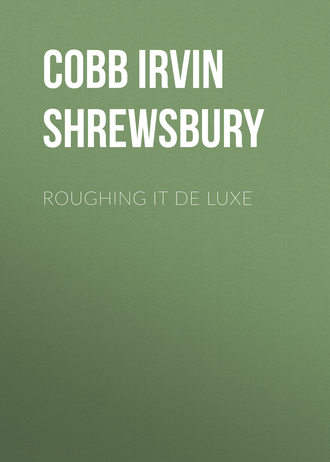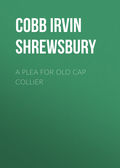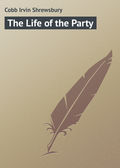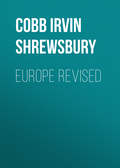
Cobb Irvin Shrewsbury
Roughing it De Luxe
We didn't see any Indians when we ran down into Mexico. However, we only ran into Mexico for a distance of a mile and a half below the California state boundary, and maybe that had something to do with it. By automobile we rode from San Diego over to the town of Tia Juana, signifying, in our tongue, Aunt Jane. Ramona, heroine of Helen Hunt Jackson's famous novel, had an aunt called Jane. I guess they had a grudge against the lady; they named this town after her.
Selling souvenirs to tourists, who come daily on sightseeing coaches from Coronado Beach and San Diego, is the principal pastime of the natives of Tia Juana. Weekdays they do this; and sometimes on a Sunday afternoon they have a bullfight in their little bullring. On such an occasion the bullfighting outfit is specially imported from one of the larger towns farther inland. Sometimes the whole troupe comes from Juarez and puts on a regular metropolitan production, with the original all-star cast. There is the gallant performer known as the armadilla, who teases the bull to desperation by waving a red shawl at him; the no less daring parabola, sticking little barbed boleros in the bull's withers; and, last of all, the intrepid mantilla, who calmly meets the final rush of the infuriated beast and, with one unerring thrust of his trusty sword, delivers the porte-cochère, or fatal stroke, just behind the left shoulder-blade, while all about the assembled peons and pianolas rend the ambient air with their delighted cry: "Hoi Polloi! Hoi Polloi! Dolce far niente!"
Isn't it remarkable how readily the seasoned tourist masters the difficulties of a foreign language? Before I had been in Mexico an hour I had picked up the intricate phraseology of the bullfight; and I was glad afterward that I took the trouble to get it all down in my mind correctly, because such knowledge always comes in handy. You can use it with effect in company—it stamps you as a person of culture and travel—and it impresses other people; but then I always could pick up foreign languages easily. I do not wish to boast—but with me it amounts to a positive gift.
It was a weekday when we visited Tia Juana, and so there was no bullfight going on; in fact, there didn't seem to be much of anything going on. Once in a while a Spigotty lady would pass, closely followed by a couple of little Spigots, and occasionally the postmaster would wake up long enough to accept a sheaf of postcards from a tourist and then go right back to sleep again. We had sampled the tamales of the country, finding them only slightly inferior to the same article as sold in Kansas City, Kansas; and we had drifted—three of us—into a Mexican café. It was about ten feet square and was hung with chromos furnished by generous Milwaukee brewers and other decorations familiar to all who have ever visited a crossroads bar-room on our own side of the line. Bottled beer appeared to be the one best bet in the drinking line, and the safest one, too; but somehow I hated—over here upon the soil of another country—to be calling for the domestic brews of our own St. Louis! Personally I desired to conform my thirst to the customs of the country—only I didn't know what to ask for. I had learned the bullfighting language, but I hadn't progressed very far beyond that point. While I was deliberating a Mexican came in and said something in Spanish to the barkeeper and the barkeeper got a bottle of a clear, almost colorless fluid out from under the counter and poured him a sherry glassful of it. So then, by means of a gesture that is universal and is understood in all climes, I indicated to the barkeeper that I would take a little of the same.
The moment, though, that I had swallowed it I realized I had been too hasty. It was mescal—an explosive in liquid form that is brewed or stilled or steeped, or something, from the juices of a certain variety of cactus, according to a favorite family prescription used by Old Nick several centuries ago when he was residing in this section. For its size and complexion I know of nothing that is worthy to be mentioned in the same breath with mescal, unless it is the bald-faced hornet of the Sunny South. It goes down easily enough—that is not the trouble—but as soon as it gets down you have the sensation of having swallowed a comet.
As I said before, I didn't see any Indians in Old Mexico, but if I had taken one more swig of the national beverage I am satisfied that not only would I have seen a great number of them, but, with slight encouragement, might have been one myself. For the purpose of assuaging the human thirst I would say that it is a mistake on the part of a novice to drink mescal—he should begin by swallowing a lighted kerosene lamp for practice and work up gradually; but the experience was illuminating as tending to make me understand why the Mexicans are so prone to revolutions. A Mexican takes a drink of mescal before breakfast, on an empty stomach, and then he begins to revolute round regardless.
On leaving Tia Juana we stopped to view the fort, which was the principal attraction of the place. It was located in the outskirts just back of the cluster of adobe houses and frame shacks that made up the town. The fort proper consisted of a mud wall about three feet high, inclosing perhaps half an acre of bare clayey soil. Outside the wall was a moat, upward of a foot deep, and inside was a barrack. This barrack—I avoid using the plural purposely—was a wooden shanty that had been whitewashed once, but had practically recovered from it since; and its walls were pierced—for artillery-fire, no doubt—with two windows, to the frames of which a few fragments of broken glass still adhered. Overhead the flag of the republic was flying; and every half-minute, so it seemed to us, a drum would beat and a bugle would blow and the garrison would turn out, looking—except for their guns—very much like a squad of district-telegraph messengers. They would evolute across the parade ground a bit and then retire to quarters until the next call to arms should sound.
We could not get close enough to ascertain what all the excitement was about, because they would not let us. We were not allowed to venture within fifty yards of the outer breastworks, or kneeworks; and even then, so the village authorities warned us, we must keep moving. A woman camera fiend from Coronado was along, and she unlimbered her favorite instrument with the idea of taking a few snapshots of this martial scene.
As she leveled the lens a yell went up from somewhere, and out of the barrack and over the wall came skipping a little officer, leaving a trail of inflammatory Spanish behind him in a way to remind you of the fireman cleaning out the firebox of the Through Limited. He was not much over five feet tall and his shabby little uniform needed the attention of the dry cleanser, but he carried a sword and two pistols, and wore a brass gorget at his throat, a pair of huge epaulets and a belt; and he had gold braid and brass buttons spangled all over his sleeves and the front of his coat, and a pair of jingling spurs were upon his heels. There was a long feather in his cap, too—and altogether, for his size, he was most impressive to behold. He charged right up to the abashed camera lady and, through an interpreter, explained to her that it was strictly against the rules to permit a citizen of a foreign power to make any pictures of the fortifications whatsoever. He appeared to nurse a horrid fear that the secret of the fortifications might become known above the line, and that some day, armed with this information, the Boy Scouts or a Young Ladies' High School might swoop down and capture the whole works. He explained to the lady, that, much as he regretted it, if she persisted in her suspicious and spylike conduct, he would have to smash her camera for her. So she desisted.
The little officer and his merry men had ample reason for being a mite nervous just then. Their country was in the midst of its spring revolution. The Madero family had just been thinned out pretty extensively, and it was not certain yet whether the Diaz faction or the Huerta faction, or some other faction, would come out on top. Besides, these gallant guardians of the frontier were a long way from headquarters and in no position to figure out in advance which way the national cat would jump next. All they knew was that she was jumping.
Every morning, so we heard, they were taking a vote to decide whether they would be Federalists that day or Liberalists, or what not; and the vote was invested with a good deal of personal interest, too, because there was no telling when a superior force might arrive from the interior; and if they had happened to vote wrong that day there was always the prospect of their being backed up against a wall, with nothing to look at except a firing squad and a row of newmade graves.
We were told that one morning, about three or four weeks before the date of our visit, the garrison had been in the barrack casting their usual ballot. They were strong Huertaists that morning—it was Viva Huerta! all the way. Just about the time the vote was being announced a couple of visiting Americans in an automobile came down the road flanking the fort. There had been a rain and the road was slippery with red mud. As the driver took the turn at the corner his wheels began skidding and he lost control. The car skewed off at a tangent, hurdled the moat, and tore a hole in the mud wall; and, as the occupants spilled sprawlingly through the gap, a front tire exploded with a loud report. The garrison took just one look out the front door, jumped to the conclusion that the Villa crowd had arrived and were shooting automobiles at them, and unanimously adjourned by the back way into the woods. Some of them did not get back until the shades of night had descended upon the troubled land.
Such is military life in our sister republic in times of war, and yet they sometimes have a very realistic imitation of the real thing over there. Revolution before last there were two separate engagements in this little town of Tia Juana. A lot of belligerents were killed and a good many more were wounded.
In an iron letter box in front of the post-office we saw a round hole where a steel-jacketed bullet had passed through after first passing through a prominent citizen. We did not see this citizen. It became necessary to bury him shortly after the occurrence referred to.
In vain I sought the red brother on my saunterings through California. In San Francisco I once thought I had him treed. On Pacific Street, a block ahead of me, I saw a group of pedestrians, wrapped in loose flowing garments of many colors. Even at that distance I could make out that they were dark-skinned and had long black hair. I said to myself: "It is probable that these persons are connected with Doctor Somebody's Medicine Show; but I don't care if they are. They are Indians—more Indians than I have seen in one crowd at one time since Buffalo Bill was at Madison Square Garden last spring. I shall look them over."
So I ran and caught up with them—but they were not Indians. They were genuine Egyptian acrobats, connected with a traveling carnival company. When Moses transmitted the divine command to the Children of Israel that they should spoil the Egyptians, the Children of Israel certainly did a mighty thorough job of it. That was several thousand years ago and those Egyptians I saw were still spoiled. I noticed it as soon as I got close to them.
In Salt Lake City I saw half a dozen Indians, but in a preserved form only. They were on display in a museum devoted to relics of the early days. In my opinion Indians do not make very good preserves, especially when they have been in stock a long time and have become shopworn, as was the case with these goods. Personally, I would not care to invest. Besides, there was no telling how old they were. They had been dug out, mummified, from the cliff-dwellers' ruins in the southern part of the state, along with their household goods, their domestic utensils, their weapons of war and their ornaments; and there they were laid out in glass cases for modern eyes to see. There were plenty of other interesting exhibits in this museum, including several of Brigham Young's suits of clothes. For a man busied with statecraft and military affairs and domestic matters, Brigham Young must have changed clothes pretty often. I couldn't keep from wondering how a man with a family like his was found the time for it.
To my mind the most interesting relic in the whole collection was the spry octogenarian who acted as guide and showed us through the place—for he was one of the few living links between the Old West and the New. As a boy-convert to Mormonism he came across the desert with the second expedition that fled westward from Gentile persecution after Brigham Young had blazed the trail. He was a pony express rider in the days of the overland mail service. He was also an Indian fighter—one of the trophies he showed was a scalp of his own raising practically, he having been present when it was raised by a friendly Indian scout from the head of the hostile who originally owned it—and he had lived in Salt Lake City when it was a collection of log shanties within the walls of a wooden stockade. And now here he was, a man away up in his eighties, but still brisk and bright, piloting tourists about the upper floor of a modern skyscraper.
We visited the museum after we had inspected the Mormon Tabernacle and had looked at the Mormon Temple—from the outside—and had seen the Beehive and the Lion House and the Eagle Gate and the painfully ornate mansion where Brigham Young kept his favorite wife, Amelia. The Tabernacle is famous the world over for its choir, its organ and its acoustics—particularly its acoustics. The guide, who is a Mormon elder detailed for that purpose, escorts you into the balcony, away up under the domed wooden roof; and as you wait there, listening, another elder, standing upon a platform two hundred feet away, drops an ordinary pin upon the floor—and you can distinctly hear it fall. At first you are puzzled to decide exactly what it sounds like; but after a while the correct solution comes to you—it sounds exactly like a pin falling. Next to the Whispering Gallery in the Capitol at Washington, I don't know of a worse place to tell your secrets to a friend than the Mormon Tabernacle. You might as well tell them to a woman and be done with it!
In Salt Lake City I had rather counted upon seeing a Mormon out walking with three or four of his wives—all at one time. I felt that this would be a distinct novelty to a person from New York, where the only show one enjoys along this line is the sight of a chap walking with three or four other men's wives—one at a time. But here, as in my quest for the Indian, I was disappointed some more. Once I thought I was about to score. I was standing in front of the Zion Coöperative Mercantile Establishment, which is a big department store owned by the Church, but having all the latest improvements, including bargain counters and special salesdays. Out of the door came an elderly gentleman attired in much broadcloth and many whiskers, and behind him trailed half a dozen soberly dressed women of assorted ages.
Filled with hope, I fell in behind the procession and followed it across to the hotel. There I learned the disappointing truth. The broadclothed person was not a Mormon at all.
He was a country bank president from somewhere back East and the women of his party were Ohio school-teachers. Anywhere except in Utah I doubt if he could have fooled me, either, for he had the kind of whiskers that go with the banking profession. For some reason whiskers are associated with the practice of banking all over this country; hallowed by custom, they have come to stand for financial responsibility. A New York banker wears those little jib-boom whiskers on the sides of his head and sometimes a pennon on his chin, whereas a country banker usually has a full-rigged face. This man's whiskers were of the old square barkentine cut. I should have known who he was by his sailing gear.
And so, disappointed in my dreams of seeing Indians on the hoof and Mormon households taking the air in family groups, I left Salt Lake City, with its fine wide streets and its handsome business district and its pure air and its background of snow-topped mountains, and started on the long homebound hike. It was late in the afternoon. We had quit Utah, with its flat plains, its garden spots reclaimed from the desert, and its endless succession of trim red-brick farmhouses, which seem to be the universal dwelling-places of the prosperous Mormon farmer.
We had departed from the old trail that Mark Twain crawled over in a stage-coach and afterward wrote about in his immortal Roughing It. The Limited, traveling forty-odd miles an hour, was skipping through the lower part of Wyoming before turning southward into Colorado. We were in the midst of an expanse of desolation and emptiness, fifteen miles from anywhere, and I was sitting on the observation platform of the rear car, watching how the shafts of the setting sun made the colors shift and deepen in the cañons and upon the sides of the tall red mesas, when I became aware that the train was slowing down.
Through the car came the conductor, with a happy expression upon his face. Behind him was a pleased-looking flagman leading by the arm a ragged tramp who had been caught, up forward somewhere, stealing a free ride.
The tramp was not resisting exactly, but at every step he said:
"You can't put me off the train between stations! It's the law that you can't put me off the train between stations!"
Neither the conductor nor the flagman said a word in answer. As the conductor reached up and jerked the bellcord the tramp, in the tone and manner of one who advances an absolutely unanswerable argument, said:
"You know, don't you, you can't put me off the train between stations?"
The train halted. The conductor unfastened a tail-gate in the guard-rail, and the flagman dropped his prisoner out through the opening. As the tramp flopped off into space I caught this remark:
"You can't put me off the train between stations."
The conductor tugged another signal on the bellcord, and the wheels began to turn faster and faster. The tramp picked himself up from between the rails. He brushed some adhering particles of roadbed off himself and, facing us, made a megaphone of his hands and sent a message after our diminishing shapes. By straining my ears I caught his words. He spoke as follows:
"You can't put me off the train between stations!"
In my whole life I never saw a man who was so hard to convince of a thing as that tramp was.







